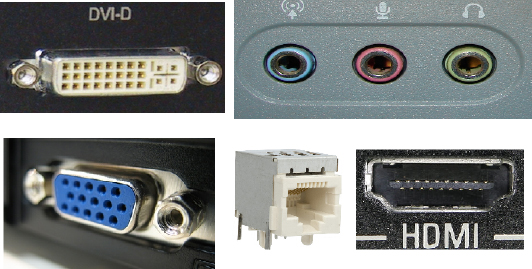Not-So-Hot-Pluggable Devices
Hardware devices that aren’t hot-pluggable require a bit more effort than hot-pluggable devices. Most require that you turn off the computer, connect the device, turn the device on, and then turn the computer back on. You might also need to install some software to get the device to work. It all depends on the device you’re connecting. As always, you have to read the instructions that came with the device for specifics. We can only provide general guidelines and examples here that give you an idea of what to expect.
Most computers have the ports pointed out in Figure 44.8. Your computer may have more or fewer such ports, and your ports probably won’t be arranged exactly like that. On a notebook computer, some of the ports are likely be on the side of the computer, perhaps hidden under a sliding or hinged door. But the basic shape of each port will be as shown in the figure.
FIGURE 44.8 Ports on the back of a computer

You can install some devices inside the computer case. These connect to sockets inside the computer case on the motherboard (also called the mainboard). The motherboard is a circuit board that provides the wiring between all the hardware devices that make up the system, including the CPU, memory (RAM), internal disk drives, and everything else. The sockets that accept these devices are called expansion slots, and the devices that go in ...
Get Windows 8 Bible now with the O’Reilly learning platform.
O’Reilly members experience books, live events, courses curated by job role, and more from O’Reilly and nearly 200 top publishers.

